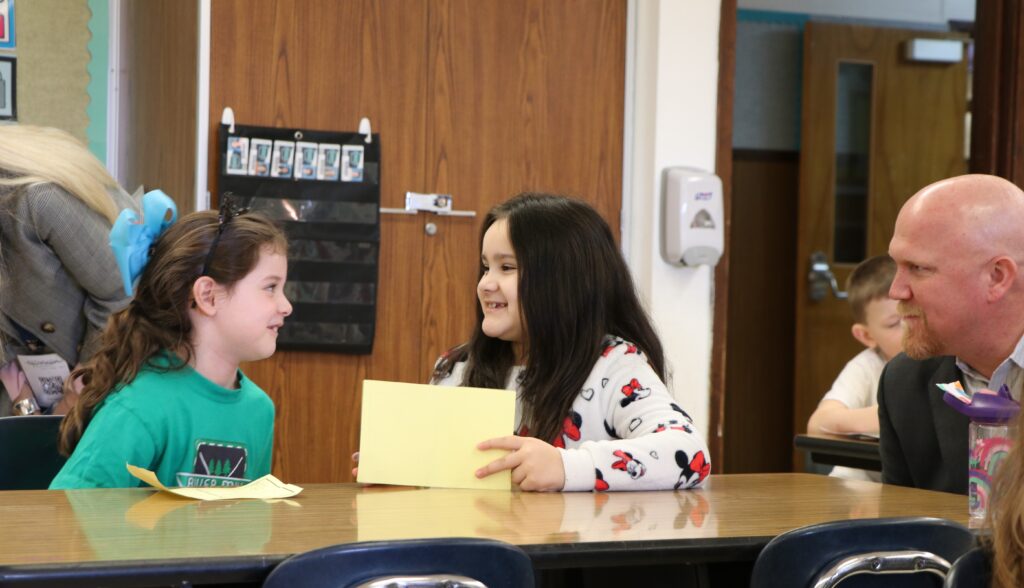
The Estacada School District, in a small former timber town southeast of Portland, has learned a lot about learning. So much, in fact, that the rest of the country wants in on the lessons.
This week, more than 200 education leaders visited Estacada for a national conference highlighting the district’s improvement science approach. Leaders from 41 school districts in 13 states, including 17 from Oregon, attended the sold-out “Destination High Performance: West Coast 2023” conference Tuesday and Wednesday.
Superintendent Ryan Carpenter described struggles with old facilities and high poverty rates – “we are not a magazine school district.” He outlined a past culture of isolationism and employee discontent that translated to dismal student attendance and graduation rates.
But over the past four years, Estacada has traveled a path to supporting student achievement that even districts with demographic or economic challenges can follow. Estacada leaders identify data-based, short-term measurable goals at the classroom, building and district level and check them regularly. Feedback loops empower staff and students to take ownership of their schools.
Graduation rates soared to 90% last year, a district record and 34 percentage points above 2019. Staff morale is also rising. The district retained 92% of staff this school year, and The Oregonian named it as one of the state’s top workplaces for 2020, 2021 and 2022.
River Mill Elementary School Vice Principal Trevor Syring has worked in the district for 27 years.
“We are on a new trajectory,” he said.
Conference attendees spent Tuesday in Estacada’s schools and Wednesday in panel sessions in nearby Troutdale. Student ambassadors took small groups into classrooms to see Estacada’s model in action and question teachers and students.
“The work they are doing here is eye-opening,” said Eric Brown, an elementary school principal from Campbell, Calif. “I see we have the capacity to do these things.”
The Campbell Union School District is about two years into changing its system with the help of Studer Education, which has also been Estacada’s partner. The consulting company works with education institutions, applying organizational lessons from the health care field.
Pat Greco, Studer coach and senior director, said systemic change requires a school board that understands stakeholders’ priorities and communicates clearly with the superintendent about goals. Patience is vital.
On Tuesday, dozens of students used similar language to describe how they are mastering their own learning. Students wielded data folders that track their progress toward goals. Even in elementary grades, students can see how individual lessons are building to a learning goal.
Before practicing a learning target Tuesday, River Mill first graders sat on a carpet before a hand-written sheet that showed daily how many could use full sentences when sharing in class. On day 1 of the lesson, it was 13. On day 4, it was 23, just two shy of the class goal of everyone. They talked about practices to improve and the value of learning.
First grade teacher Bri Jury said the short cycle goals have changed the classroom’s dynamic. Students are motivated to learn and contribute to group progress, and no one seems frustrated when falling short. Instead, they talk about not having learned it “yet,” sometimes pointing to a big “yet” lettered on the wall.
The short cycles apply in every subject. Music teacher Daniel Czyzewicz has wall charts showing one check for a chord learned and two if it is mastered. Students follow their progress by their secret number on the chart. Each day they spend a few minutes working on a chord of their choosing based on their progress.
“It’s almost too motivating,” Czyzewicz said. Students were constantly seeking individual help to level up, so in a short-cycle reevaluation he made changes so more accomplished students could teach others.
Czyzewicz said assessments initially took a lot of time to establish, but now class progress is turbocharged. Last year, the class never made it to the sometimes-tricky G chord, but many have already mastered it this year.
At the high school level, students in Olivia Hanley’s social studies class said data folders were helping them keep on task, improve their grades and build good tools for after high school.
Senior Cambria Taylor said this is her fourth high school. Her grades are up, as is her sense of accomplishment.
Hanley also regularly checks in with students, both to assess their progress and ask how she can better help them.
Jeremy Baurer, school board chair for the nearby Colton School District, said he was impressed with how students are taking responsibility for their own educations.
This school year, students have been brought into the feedback loops to make them partners in their education. Students are getting comfortable identifying where they need help and telling teachers when a lesson plan isn’t working.
It’s been a long road. Estacada started its transformation by setting clear goals and empowering staff through regular planning sessions. Scorecards for principals, directors, cabinet-level leaders and the superintendent regularly measure how the district is progressing on quantifiable goals. If a strategy isn’t working, it’s replaced or modified according to feedback.
“When we fail, the system allows us to use that as an opportunity,” said Jennifer Behrman, Estacada director of elementary schools and one of the program’s driving forces.
The Estacada School Board has unified to adopt the district’s strategic goals, tour schools to assess progress and connect with community members.
“It takes all seven of that board to move anything,” said Board Chair Ken Riedel.
He said board members provide strategic guidance and let the professionals focus on the day-to-day work.
Riedel likes having a scorecard to measure the superintendent’s progress. Carpenter, in turn, says he appreciates that it’s based on objective results such as staff retention and student graduation.
“The great thing about scorecards is that the data don’t lie,“ he said. “That’s what I want to be held accountable for.”
– Jake Arnold, OSBA
[email protected]